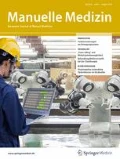Zusammenfassung
Die Palpation der Muskelspannung ist in der manuellen Medizin eines der wichtigsten Kriterien zur Beurteilung von Störungen im funktionellen Zustand des Bewegungssystems. Im vorliegenden Beitrag werden die physiologischen Mechanismen der Muskelspannung und die Ursachen für deren Erhöhung dargestellt. Vom Aufbau der Muskelfaser über spinale neuronale Verschaltungen, über die reflektorische Steuerung von Haltung und Lokomotion bis zu den Einflüssen aus psychischen Komponenten der höheren Nerventätigkeit werden die verschiedenen Aspekte eines „tonischen motorischen Systems“ im Gesamtsystem der Motorik beschrieben. Der tonische motorische Reflexbogen ist Grundbestandteil jeder Bewegung, er begleitet die Bewegung als Fixierung und Haltung der nichtbewegten Glieder und Rumpfabschnitte. Wie alle Reflexe passen sich auch die tonischen Reflexe, die die Muskelspannung regulieren, den Anforderungen und Gewohnheiten an. Hier liegt eine Ursache für Dysfunktionen im Bewegungssystem, aber auch die Chance ihrer therapeutischen Beeinflussung.
Abstract
Palpation of muscle tension is one of the proven criteria in manual medicine to evaluate the functional state and to detect dysfunctions in the motor system. Physiological mechanisms of muscle tension and the cause of elevated muscle tonus are reported. Beginning with the characteristics of muscle fibers, spinal neural interconnections and reflexes of posture and locomotion up to the influence of psychological components of higher nervous activity, the different aspects of a tonic motor system within the complex motor system are described. The tonic reflex circuit is a basic part of each movement and accompanies movement as a fixation and postural component of the non-moving parts of the body. As with all reflexes they are capable of adapting to requirement and behavior even the tonic reflexes regulating muscle tension. This may be a cause of dysfunction within the movement system but may also be the chance for a therapeutic influence.



Literatur
Adkins DL, Boychuk J, Remple MS, Kleim JA (2006) Motor training induces experience-specific patterns of plasticity across motor cortex and spinal cord. J Appl Physiol 101:1776–1782
Beyer L (2006) Muskelspannungserhöhung in der manuellen Medizin – eine physiologische Analyse (Teil 1). Manuelle Med 44:185–192
Beyer L (2009) Das tonische motorische System als Zielorgan manueller Behandlungstechniken. Manuelle Med 47:99–106
Beyer L, Seidel EJ, Grein HJ, Hartmann J (2007) Individuelle Stereotype der Koordination von Kopf- und Augenbewegungen – Ursache von Nacken und Schulterschmerzen? Manuelle Med 45:398–401
Buchmann J, Smolenski U, Arens U et al (2008) Kopf- und Gesichtsschmerz – Syndrome. Manualmedizinische Differenzialdiagnose unter Einbeziehung osteopathischer Anschauugen (Teil I). Manuelle Med 46:82–92
Carew TJ, Pinsker HM, Kandel ER (1972) Long-term habituation of a defensive withdrawal reflex in Aplysia. Science 175:451–454
Durand J, Engberg I Tyc-Dumont S (1987) L-glutamate and N-methyl-D-aspartate actions on membrane potential and conductance of cat abducens motoneurones. Neurosci Lett 79:295–300
Friedrich M, Kothe J, Grein HJ et al (2012) Nacken-Schulter-Beschwerden am Bildschirmarbeitsplatz – Beeinflussung der Augen-Kopf-Bewegung durch multifokale Brillengläser. Manuelle Med 50:505–514
Ghez C (1991) The control of movements. Motor System of the brain: reflex and voluntary control of movement. In: Kandel ER, Schwarz JH, Jessel TM (eds) Principles of neural science. Appleton & Lange, Connecticut
Hodges PW, Richardson CA (1999) Altered trunk muscle recruitment in people with low back pain with upper limb movement at different speeds. Arch Phys Med Rehabil 80:1005–1012
Iversen S, Iversen L, Saper CB (2000) The autonomic nervous system and the hypothalamus. In: Kandel ER, Schwarz JH, Jessell TM (eds) Principles of neural science. McGraw-Hill, New York
Janda V (1991) Muscle spasm – a proposed procedure for differential diagnosis. J Man Med 6:136–139
Janda V (1994) Manuelle Muskelfunktionsdiagnostik. Ullstein Mosby, Berlin
Korr IM (1947) The neural basis of the osteopathic lesion. J Am Osteopath Assoc 191–198
Laube W (2009) Sensomotorisches System. Thieme, Stuttgart
Lehmann-Horn F (2011) Motorische Systeme. In: Schmidt RF, Lang F (2011) Physiologie des Menschen. Springer Berlin Heidelberg New York, S 127–162
Marsala J, Lukacova N, Cizkova D et al (2004) Premotor nitric oxide synthase immunoreactive pathway connecting lumbar segments with the ventral motor nucleus of the cervical enlargement in the dog. J Chem Neuroanat 27:43–54
Matsushita M, Gao X, Yaginuma H (1995) Spinovestibular projections in the rat, with particular reference to projections from the central cervical nucleus to the lateral vestibular nucleus. J Comp Neurol 361:334
Mellor R, Hodges PW (2005) Motor unit synchronization is reduced in anterior knee pain. J Pain 6:550–558
Mense S (2005) Muskeltonus und Muskelschmerz. Manuelle Med 43(3):156–161
Neuhuber WL (2005) Funktionelle Anatomie des kraniozervikalen Übergangs. In: Hülse M, Neuhuber W, Wolff HD (Hrsg) Die obere Halswirbelsäule. Springer, Berlin Heidelberg New York
Paeglitis A, Eglitis E, Lesenkovs E (2005) Veränderlicher Muskeltonus bei passiver Hüftbeugung und -streckung zur Frühdiagnostik von Bewegungsstörungen in Hüfte und Becken. Manuelle Med 43(2):93–96
Passatore M, Roatta S (2006) Influence of sympathetic nervous system on sensorimotor function: whiplash associated disorders (WAD) as a model. Eur J Appl Physiol 98:423–449
Patterson MM (2001) Spinal fixation: long-term alteration in spinal reflex excitability with altered or sustained sensory inputs. In: Patterson M, Grau JW (eds) Spinal cord plasticity – alterations in reflex fuctions. Kluwer, Norwell, pp 77–99
Puta C, Herbsleb M, Weiss T, Gabriel H (2011) Rückenschmerz – Schmerzverarbeitung und aktive segmentale Stabilisation. Manuelle Med 49:1–9
Rekling JC, Funk GD, Baylis DA et al (2000) Synaptic control of motoneuronal excitability. Physiol Rev 80:767–852
Sacher R (2012) Angeborene Fremdreflexe – Haltung und Verhalten früh regulieren. Elsevier, München
Schildt-Rudloff K, Sachse J (2008) Wirbelsäule, 5. Aufl. Elsevier, Urban & Fischer, München
Schomburg ED (1990) Spinal sensorimotor systems and their supraspinal control. Neuroscience Res 7:265–340
Simons DG, Mense S (1998) Understanding and measurement of muscle tone as related to clinical muscle pain. Pain 75:1–17
Viol M (1988) Myomechanographie – eine Methode zur Messung passiv-mechanischer Eigenschaften der Muskulatur und ihre Anwendung in der Sportmedizin. Habilitationsschrift. Friedrich-Schiller-Universität, Jena
Widmann T (2009) Dysfunktionen der Kopfgelenke in Abhängigkeit vom Computergebrauch bei Kindern und Jugendlichen. Manuelle Med 47:423–433
Interessenkonflikt
Der korrespondierende Autor gibt an, dass kein Interessenkonflikt besteht.
Author information
Authors and Affiliations
Corresponding author
Rights and permissions
About this article
Cite this article
Beyer, L. Muskelspannung im System der menschlichen Motorik. Manuelle Medizin 51, 151–158 (2013). https://doi.org/10.1007/s00337-012-0991-7
Published:
Issue Date:
DOI: https://doi.org/10.1007/s00337-012-0991-7

